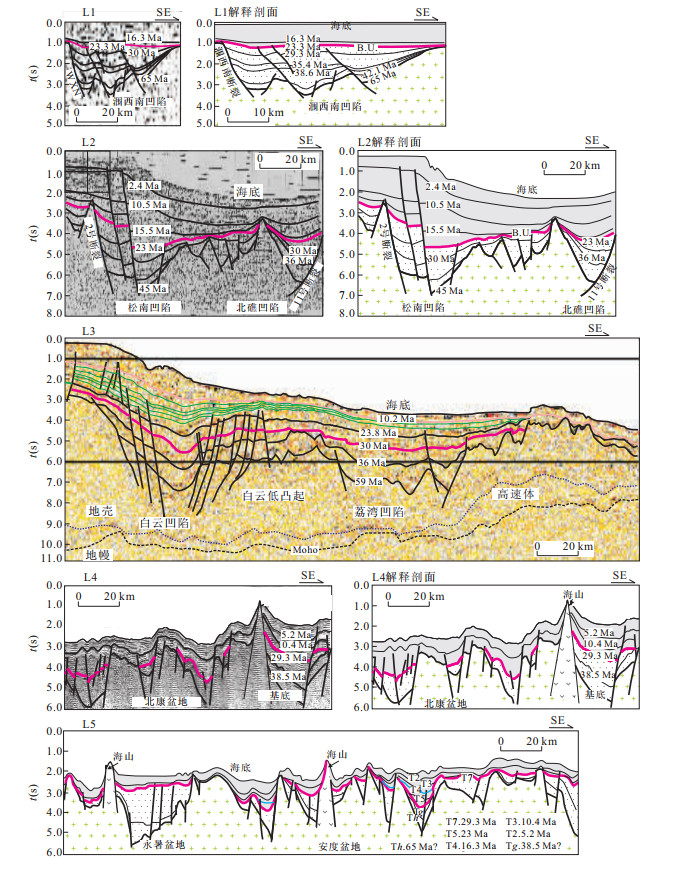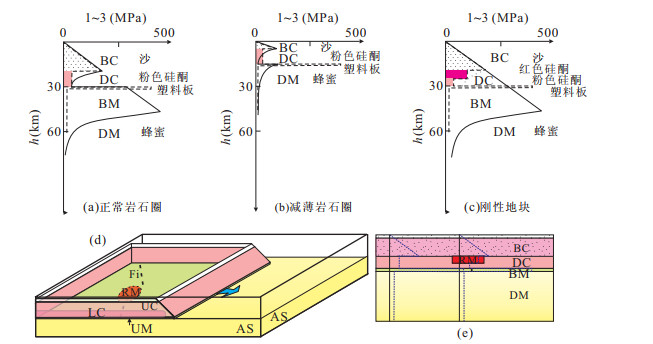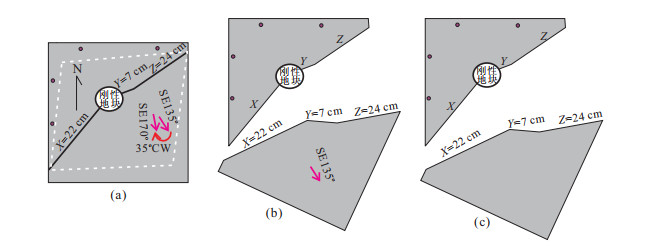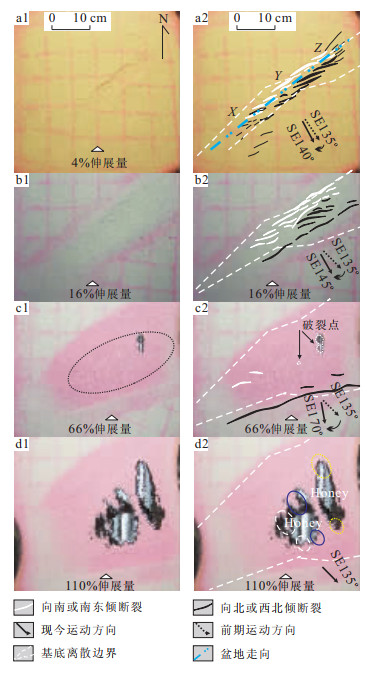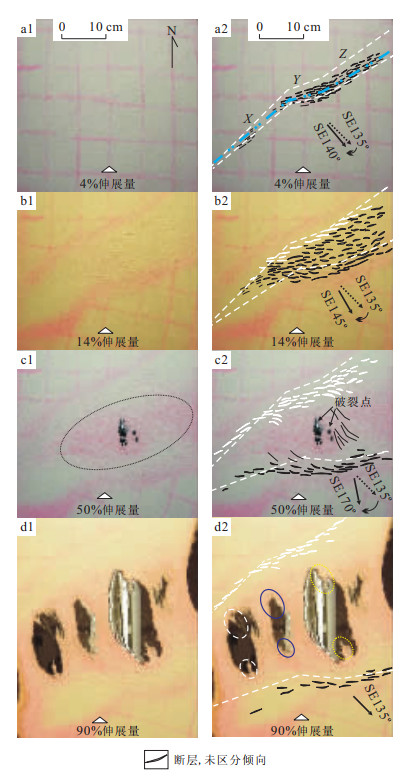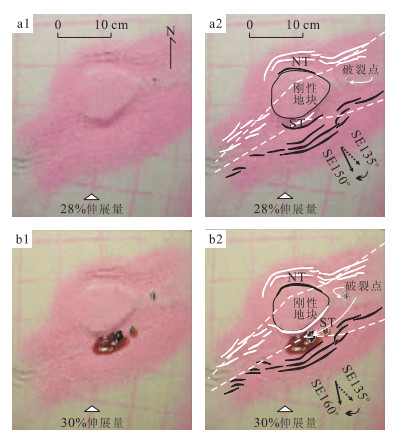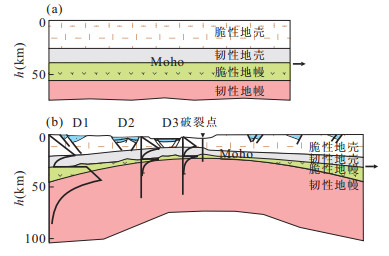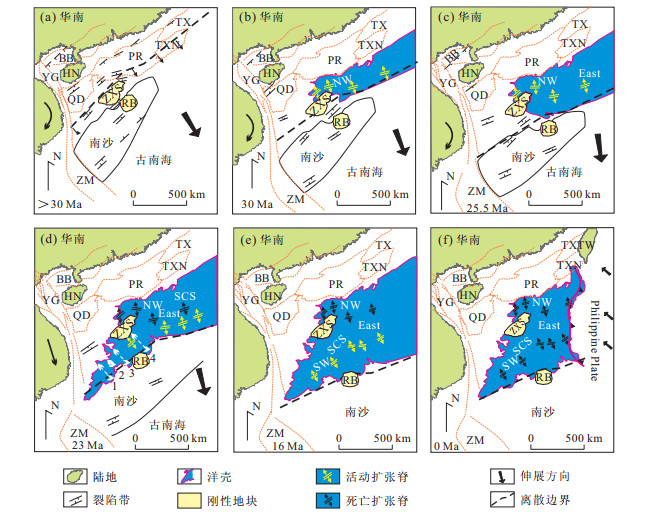Discussion on the South China Sea Evolution and Lithospheric Breakup through 3D Analogue Modeling
-
摘要: 南海的形成演化一直是国内外关注的热点之一.为了揭示南海的构造演化过程, 分析对比了3组物理模拟实验.实验结果表明, 断裂样式和裂谷带的走向与岩石圈的初始热流变结构密切相关.对比模拟结果与陆缘的断层样式, 推测在张裂初期, 陆坡区比陆架区具有相对热减薄的岩石圈, 从而导致不同构造位置上发育不同的裂陷特征.受下地壳和软流圈韧性流动的影响, 断层越是靠近扩张区, 倾角变得越平缓.实验揭示, 破裂首先以点状出现, 这些点不断扩大并互相连接形成连续的扩张区.共轭边缘常具有对称的形状, 向海盆方向对凹或者对凸.当离散边界附近有刚性块体时, 扩张区域的边界会明显受到地块边缘形态的影响.通过模拟实验, 推测破裂过程可能以较粘性的方式进行.西北次海盆的发育可能是沿着中-西沙地块北缘深裂陷槽破裂的结果.Abstract: The evolution of the South China Sea is one of the worldwide hot research spots.In order to investigate its evolution progress of tectonics, we compared three sets of analogue modeling experiments.Modeling experiments suggest that the fault patterns and orientation change of the rift zone were strongly related to the thermal situation and rheological stratification of the lithosphere.Comparing the modeling results with the fault patterns on the conjugate continental margin, we conjectured that the slope area might have born relatively hotter and thinner lithosphere than shelf area from the beginning of rifting.Due to the stretching and mantle upwelling associated with the regional extension, the initial rheological stratification was changed and therefore the rifting pattern from shelf to slope.Affected by the ductile flow of lower crust and asthenosphere, the faults became flattened, especially close to the breakup area.In the experiments, breakup developed first at isolated points, which grew and coalesced to become a single spreading area.The conjugate boundaries were either all concave or all convex.When there was a rigid massif located at the divergent boundary, the northern and southern areas of the massif thinned rapidly and developed into two deep troughs, which may finally evolve into spreading centers.The shape of the massif controls the orientation and boundary shape of the spreading area.It's supposed that the crustal breakup may go in more viscous style, and the NW sub sea basin may develop along the northern trough of the Zhongsha-Xisha massif.
-
Key words:
- South China sea /
- breakup pattern /
- tectonic evolution /
- 3D analogue modeling
-
图 1 南海及邻区主要地质构造图
磁条带解释参考Briais et al. (1993) (黄色和绿色) 及Hsu et al. (2004) (南海东北的白色线条带); NW.西北次海盆; SW.西南次海盆; YJ.阳江凹陷; WC.文昌凹陷; KP.开平凹陷; SD.顺德凹陷; LF.陆丰凹陷; CS.潮汕凹陷
Fig. 1. Tectonics of the South China sea and neighbor areas
图 2 南海南北陆缘5条解释剖面
L1据康西栋等(1994);L3据Huang et al. (2005); L4和L5据南海海洋研究所(2000);L1.解释剖面比L1剖面水平放大了两倍, 其他的解释剖面与地震剖面基本上具相同的水平比例尺; 剖面的位置见图 1
Fig. 2. Five interpreted profiles on the northern and southern margins of South China sea
表 1 实验材料与对应地质体的参数特征
Table 1. Parameters of the analogue materials and the natural counterpart

-
Allemand, P., Brun, J. P., 1991. Width of continental riftsand rheological layering of the lithosphere. Tectono-physics, 188 (1-2): 63-69. doi: 10.1016/0040-1951(91)90314-I Briais, A., Patriat, P., Tapponnier, P., 1993. Updated inter-pretation of magnetic anomalies and seafloor spreadingin the South China sea: Implications for the Tertiarytectonics of Southeast Asia. J. Geophys. Res. , 98 (B4): 6299-6328. doi: 10.1029/92JB02280 Brun, J. P., Buck, R., Mcclay, K., et al., 1999. Narrow riftsversus wide rifts: Inferences for the mechanics of riftingfrom laboratory experiments. Philosophical Transac-tions: Mathematical, Physical and Engineering Sciences, 357 (1753): 695-712. doi: 10.1098/rsta.1999.0349 Carter, N. L., Tsenn, M. C., 1987. Flow properties of conti-nental lithosphere. Tectonophysics, 136 (1-2): 27-63. doi: 10.1016/0040-1951(87)90333-7 Chen, C. M., Shi, H. S., Xu, S. C., et al., 2003. The condi-tion of oil and gas reservoir formation in the East of Pearl river Mouth basin. Science Press, Beijing, 1-31 (in Chinese). Clift, P., Lin, J., 2001. Preferential mantle lithospheric ex-tension under the South China margin. Marine and Pe-troleum Geology, 18 (8): 929-945. doi: 10.1016/S0264-8172(01)00037-X Clift, P., Lin, J., Barckhausen, U., 2002. Evidence of lowflexural rigidity and low viscosity lower continentalcrust during continental break-up in the South Chinasea. Marine and Petroleum Geology, 19 (8): 951-970. doi: 10.1016/S0264-8172(02)00108-3 Corti, G., Bonini, M., Conticelli, S., et al., 2003. Analoguemodelling of continental extension: Areviewfocused onthe relations between the patterns of deformation andthe presence of magma. Earth-Science Reviews, 63 (3-4): 169-247. doi: 10.1016/S0012-8252(03)00035-7 Corti, G., Bonini, M., Innocenti, F., et al., 2001. Centrifugemodels simulating magma emplacement during obliquerifting. Journal of Geodynamics, 31 (5): 557-576. doi: 10.1016/S0264-3707(01)00032-1 Davy, P., Cobbold, P. R., 1991. Experiments on shorteningof a4-layer model of the continental lithosphere. Tec-tonophysics, 188 (1-2): 1-25. Dunbar, J. A., Sawyer, D. S., 1988. Continental rifting at pre-existing lithospheric weaknesses. Nature, 333 (2): 450-452. Gradstein, F. M., Ogg, J. G., Smith, A. G., 2004. A geologictime scale2004. Cambridge University Press, UK. Hall, R., 2002. Cenozoic geological and plate tectonic evolu-tion of SE Asia and the SW Pacific: Computer-based reconstructions, model and animations. Journal of Asian Earth Sciences, 20 (4): 353-431. Hazebroek, H. P., Tan, D. N. K., 1993. Tertiary tectonicevolution of the NW Sabah continental margin. In: Teh, G. H., ed, Proceedings of the symposium on tectonicframework and energy resources of the western marginof Pacific basin. Bull. Geol. Soc. Malaysia, 33: 195-210. Hsu, S. K., Yeh, Y. C., Doo, W. B., et al., 2004. New ba-thymetry and magnetic lineations identifications in thenorthernmost South China sea and their tectonic impli-cations. Marine Geophysical Researches, 25 (1-2): 29-44. doi: 10.1007/s11001-005-0731-7 Huang, C. J., Zhou, D., Sun, Z., et al., 2005. Deep crustalstructure of Baiyun sag, northern South China sea revealed fromdeep seismic reflection profile. Chinese Science Bulletin, 50 (11): 1131-1138. doi: 10.1360/04wd0207 Hutchison, C. S., 1996. The'Rajang accretionary prism' and 'Lupar Line' problem of Borneo. In: Hall, R., Blundell, D., eds, Tectonic evolution of Southeast Asia. The Geological Society of London, Special Publications, 106: 247-262. Jin, Q. H., Li, T. G., 2000. Regional geologic tectonics of the Nansha sea area. Marine Geology & Quaternary Geology, 20 (1): 1-8 (in Chinese with English abstract). Kang, X. D., Zhao, W. C., Pan, Z. G., et al., 1994. Study onarchitecture of sequence stratigraphic framework of Beibuwan basin. Earth Science-Journal of China University Geosciences, 19 (4): 493-502 (in Chinese with English abstract). Keep, M., 2003. Physical modelling of deformation in the Tasman orogenic zone. Tectonophysics, 375 (1-4): 37-47. doi: 10.1016/j.tecto.2003.06.002 Kirby, S. H., 1983. Rheology of the lithosphere. Rev. Geo-phys. Space Phys. , 21 (6): 1458-1487. Li, P. L., 1994. Structural features and oil-and-gas accumula-tion in Peal River Mouth basin. Guangdong Geology, 9 (4): 21-28 (in Chinese with English abstract). Lin, A. T., Watts, A. B., Hesselbo, S. P., 2003. Cenozoic stratigraphy and subsidence history of the South Chinasea margin in the Tai wan region. Basin Research, 15 (4): 453-478. doi: 10.1046/j.1365-2117.2003.00215.x Lu, B. Q., Xu, G. Q., Wang, H. G., et al., 2002. Sea floor spreading recorded by drowning events of Cenozoic car-bonate platforms in the South China sea. Chinese Journal of Geology, 37 (4): 405-414 (in Chinese with Eng-lish abstract). Mart, Y., Dauteuil, O., 2000. Analogue experiments of prop-agation of oblique rifts. Tectonophysics, 316 (1-2): 121-132. doi: 10.1016/S0040-1951(99)00231-0 Pubellier, M., Cobbold, P. R., 1996. Analogue models for thetranspressional docking of volcanic arcs in the western Pacific. Tectonophysics, 253, doi: 10:0040-1951. Qin, G. Q., 2000. Investigation to the stratigraphy and con-struction of the comprehensive geologic columnar sec-tion of Cenozoic formationin Pearl River Mouth basin. China Offshore Oil and Gas (Geology), 14 (1): 21-28 (in Chinese with English abstract). Ranalli, G., 1995. Rheology of the earth (2nd edition). Chap-man & Hall, London, 413. Ranalli, G., Murphy, D. C., 1987. Rheological stratificationof the lithosphere. Tectonophysics, 132 (4): 281-295. doi: 10.1016/0040-1951(87)90348-9 Ru, K., 1988. The development of a superimposed basin onthe northern margin of the South China sea and its tectonic significance. Oil & Gas (Geology), 9 (1): 22-31. Shao, L., Lei, Y. C., Pang, X., et al., 2005. Tectonic evolu-tion and its controlling for sedimentary environment in Pearl River Mouth basin. Journal of Tongji University (Natural Science) (China), 33 (9): 1177-1181 (in Chinese with English abstract). Shao, L., Li, X. H., Wang, P. X., 2004. Sedimentary recordof the tectonic evolution of the South China sea sincethe Oligocene-Evidence from deep sea sediments ofODP site1148. Advance in Earth Sciences, 19 (4): 539-544 (in Chinese with English abstract). Sims, D., Ferrill, D. A., Stamatakos, J. A., 1999. Role of aductile decollement in the development of pull-apart basins: Experimental results and natural examples. Journal of Structural Geology, 21 (5): 533-554. doi: 10.1016/S0191-8141(99)00010 South China Sea Institute of Oceanology, 2000. Tectonic evo-lution and dynamics of the Nansha area (Dangerousground) in South China sea. Research Report of'95'National I mportant Scientific Project (in Chinese). Sun, Z., Pang, X., Zhong, Z. H., et al., 2005. Dynamics of Tertiary tectonic evolution of the Baiyun sag in the Pearl river Mouth basin. Earth Science Frontiers, 12 (4): 489-498 (in Chinese with English abstract). Sun, Z., Zhong, Z. H., Zhou, D., et al., 2006. Research on the dynamics of the South China sea opening: Evidence from analogue modeling. Science in China (Ser. D), 49 (10): 1053-1069. doi: 10.1007/s11430-006-1053-6 Tapponnier, P., Peltzer, G., Armijo, R., 1986. On the mechanics of the collision between India and Asia. The Geological Society London, Special Publications, 19 (1): 113. doi: 10.1144/GSL.SP.1986.019.01.07 Taylor, B., Hayes, D. E., 1983. Origin and history of the South China sea basin. In: Hayes, D. E., ed., The tectonic and geologic evolution of Southeast Asian seas andislands. American Geophysical Union Geophysical Monograph Series, 27: 23-56. Tommasi, A., Vauchez, A., 2001. Continental rifting parallelto ancient collisional belts: An effect of the mechanicalanisotropy of the lithospheric mantle. Earth and Planetary Science Letters, 185: 199-210. doi: 10.1016/S0012-821X(00)00350-2 Tron, V., Brun, J. P., 1991. Experiments on oblique riftinginbrittle-ductile systems. Tectonophysics, 188 (1-2): 71-84. doi: 10.1016/0040-1951(91)90315-J Versfelt, J., Rosendahl, B. R., 1989. Relationships betweenpre-rift structure and rift architecture in Lakes Tangan-yika and Malawi, East Africa. Nature, 337: 354-357. doi: 10.1038/337354a0 Xie, W. Y., Sun, Z., Zhang, Y. W., et al., 2007. The fault activity of Qiongdongnan basin andits kinematic analysis. Marine Geology and Quaternary Geology, 27 (1): 71-78 (in Chinese with English abstract). Xie, X. N., Muller, R. D., Li, S. T., et al., 2006. Origin ofanomalous subsidence along the northern South China Sea margin and its relationship to dynamic topography. Marine and Petroleum Geology, 23 (7): 745-765. doi: 10.1016/j.marpetgeo.2006.03.004 Yang, Z., Besse, J., 1993. Paleomagnetic study of Permianand Mesozoic sedimentary rocks from northern Thai-land supports the extrusion model for Indochina. Earthand Planetary Science Letters, 117 (3-4): 525-552. doi: 10.1016/0012-821X(93)90101-E Yao, B. C., Wan, L., Liu, Z. H., et al., 2004. Tectonic dynamics of Cenozoic sedimentary basins and hydrocarbon resources in the South China sea. Earth Science-Journal of China University of Geosciences, 29 (5): 543-549 (in Chinese with English abstract). Zhang, Q. M., Hao, F., 1997. Evolution and petroleum sys-temof the Ying-Qiong basin. Sciences in China (Ser. D), 27 (5): 149-154. Zhang, Y. F., Sun, Z., Zhou, D., et al., 2007. The Cenozoicstretching feature of the northern continental margin of South China sea and its dynamic significance. Science in China (Ser. D), 37 (12): 1-8 (in Chinese). Zhong, Z. H., 2000. The dynamics and hydrocarbon accumu-lation of Ying-Qiong basin, west of South China sea[Dissertation]. Nanjing University, Nanjing (in Chinese). Zhou, D., Ru, K., Chen, H. Z., 1995. Kinematics of Cenozoicextension on the South China sea continental marginand its implications for the tectonic evolution of the region. Tectonophysics, 251 (1-4): 161-177. doi: 10.1016/0040-1951(95)00018-6 Ziegler, P. A., Cloetingh, S., 2004. Dynamic processes controlling evolution of rifted basins. Earth-Science Reviews, 64 (1-2): 1-50. doi: 10.1016/S0012-8252(03)00041-2 陈长民, 施和生, 许世策, 等, 2003. 珠江口盆地(东部) 第三系油气藏形成条件. 北京: 科学出版社. 金庆焕, 李唐根, 2000. 南沙海域区域地质构造. 海洋地质与第四纪地质, 20 (1): 1-8. https://www.cnki.com.cn/Article/CJFDTOTAL-HYDZ200001000.htm 康西栋, 赵文翠, 潘治贵, 等, 1994. 北部湾盆地层序地层格架及其内部构成. 地球科学—中国地质大学学报, 19 (4): 493-502. https://www.cnki.com.cn/Article/CJFDTOTAL-DQKX199404013.htm 李平鲁, 1994. 珠江口盆地构造特征与油气聚集. 广东地质, 9 (4): 21-28. 吕炳全, 徐国强, 王红罡, 等, 2002. 南海新生代碳酸盐台地淹没事件记录的海底扩张. 地质科学, 37 (4): 405-414. doi: 10.3321/j.issn:0563-5020.2002.04.003 南海海洋研究所, 2000. 南海南沙地区构造演化与动力学. "95"国家重大科学项目研究报告. 秦国权, 2000. 珠江口盆地新生代地层问题讨论及综合柱状剖面图编制. 中国海上油气(地质), 14 (1): 21-28. https://www.cnki.com.cn/Article/CJFDTOTAL-ZHSD200001004.htm 邵磊, 李献华, 汪品先, 等, 2004. 南海渐新世以来构造演化的沉积记录—ODP1148站深海沉积物中的证据. 地球科学进展, 19 (4): 539-544. doi: 10.3321/j.issn:1001-8166.2004.04.008 邵磊, 雷永昌, 庞雄, 等, 2005. 珠江口盆地构造演化及对沉积环境的控制作用. 同济大学学报(自然科学版), 33 (9): 1177-1181. doi: 10.3321/j.issn:0253-374X.2005.09.007 孙珍, 庞雄, 钟志洪, 等, 2005. 珠江口盆地白云凹陷新生代构造演化动力学. 地学前缘, 12 (4): 489-498. doi: 10.3321/j.issn:1005-2321.2005.04.018 孙珍, 钟志洪, 周蒂, 等, 2006. 南海的发育机制研究—相似模拟证据. 中国科学(D辑), 36 (9): 797-810. https://www.cnki.com.cn/Article/CJFDTOTAL-JDXK200609001.htm 谢文彦, 孙珍, 张一伟, 等, 2007. 琼东南盆地断裂构造特征与成因机制分析. 海洋地质与第四纪地质, 27 (1): 71-78. 姚伯初, 万玲, 刘振湖, 等, 2004. 南海海域新生代沉积盆地构造演化的动力学特征及其油气资源. 地球科学—中国地质大学学报, 29 (5): 543-549. https://www.cnki.com.cn/Article/CJFDTOTAL-DQKX200405006.htm 张云帆, 孙珍, 周蒂, 等, 2007. 南海北部陆缘新生代地壳减薄特征及其动力学意义. 中国科学(D辑), 37 (12): 1609-1616. https://www.cnki.com.cn/Article/CJFDTOTAL-JDXK200712007.htm 钟志洪, 2000. 南海西部莺琼盆地构造形成机制与油气聚集研究[博士论文]. 南京: 南京大学. -









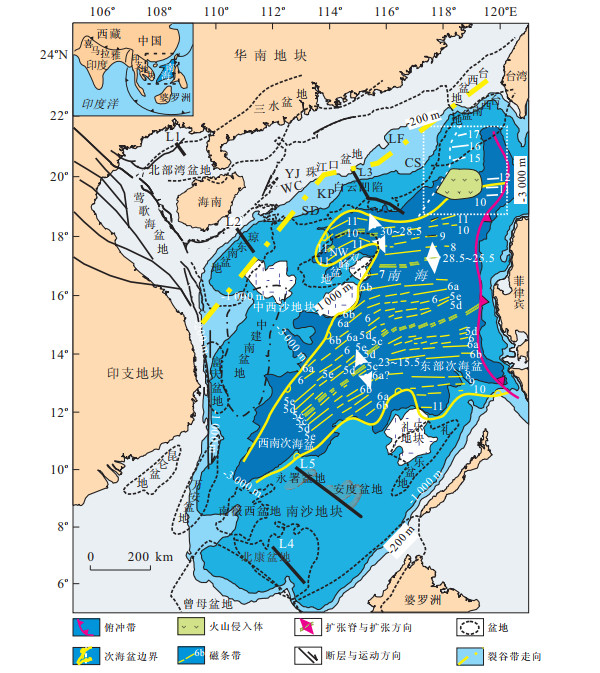
 下载:
下载:
